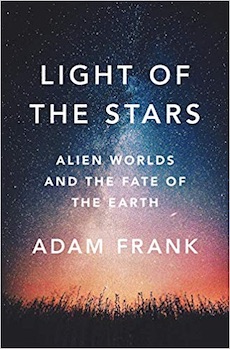Winner of the 2019 ΦBK Science Award
By Catherine A. Pilachowski
In the nearly 25 years since the discovery of the first exoplanets around sun-like stars, astronomers frequently have been surprised by new discoveries. The first detections of Jupiter-like planets orbiting their stars at distances just 4% of the distance of Earth from its star, our sun, were completely unexpected. Subsequent surprises included planets unlike any in our system, with planetary masses larger than Earth’s but less than Neptune’s; planetary system architectures so unlike our own, with very different arrangements than our own rocky, inner terrestrial planets and stately, outer gas giants; and families of planets orbiting close-by faint, dim stars with masses less than 10% of our sun’s. These findings, along with the nearly 6,000 confirmed and candidate exoplanets, have given us new perspectives on planets and deepened our understanding of the prospect of life elsewhere in the Milky Way.
Adam Frank explores this new perspective, starting with our own familiar Venus, Earth, and Mars. What makes these planets so different? Why is Venus the hottest planet in the solar system and not Mercury? What factors influence climate on planets, including our Earth, and how does climate vary over short and long time scales? We learn about Carl Sagan’s discovery of the greenhouse effect on Venus, explaining its extreme temperature. And we learn about early Mars, when water flowed freely over its surface.
Frank introduces his readers to complex climate models that allow planetary scientists, including scientists studying Earth’s climate, to run the clock backwards and forwards and to understand how each planet’s climate today came to be. These same models, applied to Earth, predict what might happen given specific circumstances, and in particular those circumstances Earthlings are facing today as our climate warms from increasing concentrations of greenhouse gases. What’s clear from the models is that climate is not constant. Climates change, forced by changing atmospheric composition, changing surface morphology, and changing solar radiation. And human beings are changing Earth’s climate.
With knowledge of the near-ubiquity of planetary systems around stars, as well as this deeper understanding of climate, Frank explores the probability of life elsewhere. Astronomical surveys conducted by NASA’s Kepler and TESS missions have established that something like 20% of all stars are orbited by planets with conditions where life could arise. But what is the probability that other civilizations have arisen somewhere in the universe during the last 13 billion years? Frank answers this question with statistics, and only an extreme pessimist could argue with his conclusion that the probability that we are not the first civilization is high.
So, if civilizations do exist, where are they? This question, known as the Fermi Paradox, was first posed by physicist Enrico Fermi in 1950, and many have proposed imaginative answers. Frank approaches the Fermi Paradox with the tools of climate science. Civilizations need energy, and energy production affects a planet’s environment. A civilization’s options to produce the energy it needs are limited: combustion; water, wind, and tidal; geothermal; solar; and nuclear energy. The choices an alien civilization makes to produce energy will determine its impact on the stability of planetary climate, and ultimately the lifetime of that civilization. Good choices can lead to stability; poor choices will lead to civilization-ending catastrophe.
Like all good science books written for general audiences, Light of the Stars tells a story. The theme of that story is that both life and the civilization that life can lead to play important roles in the evolution of a planet. And Adam Frank’s story shares a new and compelling perspective on planets, including our own home planet, Earth.
Catherine A. Pilachowski (ΦBK, Indiana University) is a Distinguished Professor and Daniel Kirkwood Chair in Astronomy at Indiana University Bloomington.




